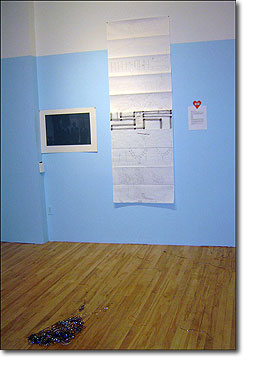Apexart,
Oct 11, 2003 - Nov 08, 2003
New York, NY, USA
To Be Political it has to Look Nice
by Raúl Zamudio
To be sure, there were references in the curatorial statement to outdated perceptions from within Latin America itself, specifically José Vasconcelos’ concept of "The Cosmic Race." This term, however, was specific to Mexico in a particular historical moment, and Vasconcelos was responding to and was a product of certain Mexican social and political contexts. By not stating this one was left to wonder if the curator was parodying or just generalizing by graphing this native Mexican concept to identity politics outside of it. And consequently by using this term from the last millennium as foil to address contemporary social and political phenomena across the South American board so to speak, it evinced a lack of specificity and historicity. This inconsistency was also evident in the works chosen, and it wasn’t that the works lacked merit. Some of the works and events that coincided with the show were inserted at the last minute, giving the exhibition an air of serendipity and of anything goes mentality. Yet even the works that had political edge were blunt on further inspection or seemed to have nothing to do with the exhibition whatsoever. Carolina Caycedo’s piece titled How to Get a British Passport was an interesting proposal, and her piece would be more interesting still if she was from a country that had a historically colonial relationship with England. Here is a person who was born in England, and granted that the artist’s parents are Columbian and she had lived in Bogota for some time, making a piece on how to obtain a British passport did not quite have the potential that it could if she was an artist from India, for instance. A work that didn’t seem to fit in the curatorial "framework" at all was from Javier Téllez. His contribution titled Socle du Monde, was a sculpture that formally converge Andy Warhol’s Silver Clouds and the famous Manzoni piece from which Téllez’ work is titled. The poetic gesture of the work’s upside down placement was not bereft of unintended irony, however: for now the work literally and metaphorically hovered beyond the reach of the exhibition. It was a guessing game as to whether this piece was "political" or if it was chosen for some other obscure reason. One artist who was literally in sync with the show was Stefan Bruggeman, and probably because his piece was also the title of the exhibition. To Be Political It Has To Look Nice consists of text stating the title and made of neon, and its ostensible hermetic quality figuratively reminded me of one of Bruggeman’s other works: Looks Conceptual. There were numerous works that were engaging including pieces from El Vicio, Ediciones El Chino, Sebastian Ramirez and Galleria Chilena. What it really came down to is that these overall interesting artists were at the mercy of the show’s overly porous framework; for by including such disparate works that were not linked in some thematic way, it seemed that anything could have been exhibited as long as it "looked political," which in the case of the exhibition was purely subjective. There were some interesting observations in the brochure that was ingeniously formatted as manifesto or broadside. Especially poignant in the "manifesto" was the discussion of the "New Exoticism." This portion of the brochure essay took to task curators who turn Mexico City into a fetish by highlighting its violence, crime and so forth. However, this same section had such exhortations as "Es el Che the Answer to Latin America?", "Es el Chavez the Answer to Latin America?" and "Es el Chavo the Answer to Latin America?" These proclamations foreground how native icons can produce unintended cultural generalizations outside of Latin America, yet exhibitions such as this that attempt to combat stereotypes with stereotypes have the propensity to reiterate them from within as well. While 1980s identity politics and "stereotypes" as a thematic have generally gone the route of more intellectually denser discourses around post-identity frameworks, exhibitions such as To Be Political It Has To Look Nice need more rigorous contexts otherwise they feel doctrinaire, and to do so is to reiterate a stereotype about political shows in general and in this particular exhibition, about South American artists. This reminds me of an anecdote about the Latin American Artists of the Twentieth-Century show that was at the Museum of Modern Art in the 1990s. A friend who worked in the events department told me they were in a cultural conundrum as to what to serve its guests as the opening date approached. MOMA came to the conclusion that Latin Americans prefer things as tamales, beans, "taquitos," tortilla chips, and guacamole and like to drink rum mixed with Goya fruit juice. There is nothing innately wrong with any of these foods, nor with working with stereotypes. But it is a little heavy-handed to thematically serve a stereotype to sophisticated art audiences these days; if one does, it better be on a formally and conceptually complex level as Kara Walker, if not, then there is a risk of turning into one.
In the same way that Adorno pointed out capitalism’s conversion of the museum into mausoleum, of the neutralization of art by way of the culture industry, To Be Political It Has to Look Nice would probably suit well with whatever it was it was politically targeting. Through its unintended self-parody and occasional side-show antics, its criticality fell short and the only thing one could say about it was that it attempted to look political rather than being political. On the other hand, the show did look nice.
|













